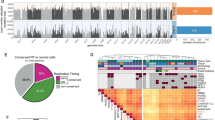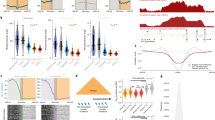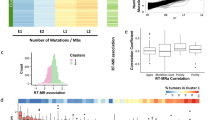Abstract
Somatic copy-number alterations (SCNA) are a hallmark of many cancer types, but the mechanistic basis underlying their genome-wide patterns remains incompletely understood. Here we integrate data on DNA replication timing, long-range interactions between genomic material, and 331,724 SCNAs from 2,792 cancer samples classified into 26 cancer types. We report that genomic regions of similar replication timing are clustered spatially in the nucleus, that the two boundaries of SCNAs tend to be found in such regions, and that regions replicated early and late display distinct patterns of frequencies of SCNA boundaries, SCNA size and a preference for deletions over insertions. We show that long-range interaction and replication timing data alone can identify a significant proportion of SCNAs in an independent test data set. We propose a model for the generation of SCNAs in cancer, suggesting that data on spatial proximity of regions replicating at the same time can be used to predict the mutational landscapes of cancer genomes.
This is a preview of subscription content, access via your institution
Access options
Subscribe to this journal
Receive 12 print issues and online access
$209.00 per year
only $17.42 per issue
Buy this article
- Purchase on SpringerLink
- Instant access to full article PDF
Prices may be subject to local taxes which are calculated during checkout



Similar content being viewed by others
References
Beroukhim, R. et al. The landscape of somatic copy-number alteration across human cancers. Nature 463, 899–905 (2010).
Bell, S.P. & Dutta, A. DNA replication in eukaryotic cells. Annu. Rev. Biochem. 71, 333–374 (2002).
Gilbert, D.M. Evaluating genome-scale approaches to eukaryotic DNA replication. Nat. Rev. Genet. 11, 673–684 (2010).
Hansen, R.S. et al. Sequencing newly replicated DNA reveals widespread plasticity in human replication timing. Proc. Natl. Acad. Sci. USA 107, 139–144 (2010).
Woodfine, K. et al. Replication timing of human chromosome 6. Cell Cycle 4, 172–176 (2005).
Lieberman-Aiden, E. et al. Comprehensive mapping of long-range interactions reveals folding principles of the human genome. Science 326, 289–293 (2009).
Meister, P., Taddei, A. & Gasser, S.M. In and out of the replication factory. Cell 125, 1233–1235 (2006).
Ryba, T. et al. Evolutionarily conserved replication timing profiles predict long-range chromatin interactions and distinguish closely related cell types. Genome Res. 20, 761–770 (2010).
Saleh-Gohari, N. et al. Spontaneous homologous recombination is induced by collapsed replication forks that are caused by endogenous DNA single-strand breaks. Mol. Cell. Biol. 25, 7158–7169 (2005).
Lisby, M., Barlow, J.H., Burgess, R.C. & Rothstein, R. Choreography of the DNA damage response: spatiotemporal relationships among checkpoint and repair proteins. Cell 118, 699–713 (2004).
Hastings, P.J., Lupski, J.R., Rosenberg, S.M. & Ira, G. Mechanisms of change in gene copy number. Nat. Rev. Genet. 10, 551–564 (2009).
Hastings, P.J., Ira, G. & Lupski, J.R. A microhomology-mediated break-induced replication model for the origin of human copy number variation. PLoS Genet. 5, e1000327 (2009).
Lukasova, E. et al. Localisation and distance between ABL and BCR genes in interphase nuclei of bone marrow cells of control donors and patients with chronic myeloid leukaemia. Hum. Genet. 100, 525–535 (1997).
Wijchers, P.J. & de Laat, W. Genome organization influences partner selection for chromosomal rearrangements. Trends Genet. 27, 63–71 (2011).
Misteli, T. & Soutoglou, E. The emerging role of nuclear architecture in DNA repair and genome maintenance. Nat. Rev. Mol. Cell Biol. 10, 243–254 (2009).
Futreal, P.A. et al. A census of human cancer genes. Nat. Rev. Cancer 4, 177–183 (2004).
TCGA. Comprehensive genomic characterization defines human glioblastoma genes and core pathways. Nature 455, 1061–1068 (2008).
TCGA. Integrated genomic analyses of ovarian carcinoma. Nature 474, 609–615 (2011).
Kobayashi, T. & Ganley, A.R. Recombination regulation by transcription-induced cohesin dissociation in rDNA repeats. Science 309, 1581–1584 (2005).
Zhang, F., Gu, W., Hurles, M.E. & Lupski, J.R. Copy number variation in human health, disease, and evolution. Annu. Rev. Genomics Hum. Genet. 10, 451–481 (2009).
Stamatoyannopoulos, J.A. et al. Human mutation rate associated with DNA replication timing. Nat. Genet. 41, 393–395 (2009).
Watanabe, Y. et al. Chromosome-wide assessment of replication timing for human chromosomes 11q and 21q: disease-related genes in timing-switch regions. Hum. Mol. Genet. 11, 13–21 (2002).
Fisher, R.A. The Design of Experiments, edn. 8 (Hafner, Edinburgh, 1966).
Rheinfurth, M.H. & Howell,, L.W. Probability and Statistics in Aerospace Engineering. NASA, (1998).
Slack, A., Thornton, P.C., Magner, D.B., Rosenberg, S.M. & Hastings, P.J. On the mechanism of gene amplification induced under stress in Escherichia coli. PLoS Genet. 2, e48 (2006).
De, S. & Michor, F. DNA secondary structures and epigenetic determinants of cancer genome evolution. Nat. Struct. Mol. Biol. 18, 950–955 (2011).
Zhao, J., Bacolla, A., Wang, G. & Vasquez, K.M. Non-B DNA structure-induced genetic instability and evolution. Cell. Mol. Life Sci. 67, 43–62 (2010).
Snyder, R.D. Consequences of the depletion of cellular deoxynucleoside triphosphate pools on the excision-repair process in cultured human fibroblasts. Mutat. Res. 200, 193–199 (1988).
Song, S., Wheeler, L.J. & Mathews, C.K. Deoxyribonucleotide pool imbalance stimulates deletions in HeLa cell mitochondrial DNA. J. Biol. Chem. 278, 43893–43896 (2003).
Kumar, D., Viberg, J., Nilsson, A.K. & Chabes, A. Highly mutagenic and severely imbalanced dNTP pools can escape detection by the S-phase checkpoint. Nucleic Acids Res. 38, 3975–3983 (2010).
Meyerson, M., Gabriel, S. & Getz, G. Advances in understanding cancer genomes through second-generation sequencing. Nat. Rev. Genet. 11, 685–696 (2010).
Koboldt, D.C., Ding, L., Mardis, E.R. & Wilson, R.K. Challenges of sequencing human genomes. Brief. Bioinform. 11, 484–498 (2010).
Acknowledgements
We would like to thank K. Polyak, A. Melnick, K.J. Patel, A. Chakravarti and R. Beroukhim for comments and discussions. S.D. is a recipient of Human Frontier Science Program long-term fellowship and is a Research Fellow at King's College, Cambridge. This work was funded by the National Cancer Institute's initiative to found Physical Science-Oncology Centers (U54CA143798).
Author information
Authors and Affiliations
Contributions
S.D. and F.M. designed the experiments and wrote the paper. S.D. performed the analysis.
Corresponding authors
Ethics declarations
Competing interests
The authors declare no competing financial interests.
Supplementary information
Supplementary Text and Figures
Supplementary Modules 1–10 (PDF 915 kb)
Rights and permissions
About this article
Cite this article
De, S., Michor, F. DNA replication timing and long-range DNA interactions predict mutational landscapes of cancer genomes. Nat Biotechnol 29, 1103–1108 (2011). https://doi.org/10.1038/nbt.2030
Received:
Accepted:
Published:
Issue Date:
DOI: https://doi.org/10.1038/nbt.2030
This article is cited by
-
Replication timing and epigenome remodelling are associated with the nature of chromosomal rearrangements in cancer
Nature Communications (2019)
-
Nuclear topology modulates the mutational landscapes of cancer genomes
Nature Structural & Molecular Biology (2017)
-
Order from clutter: selective interactions at mammalian replication origins
Nature Reviews Genetics (2017)
-
HSA: integrating multi-track Hi-C data for genome-scale reconstruction of 3D chromatin structure
Genome Biology (2016)
-
Intragenic duplication in the PHKD1 gene in autosomal recessive polycystic kidney disease
BMC Medical Genetics (2015)



